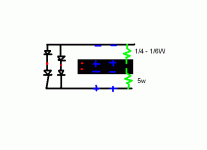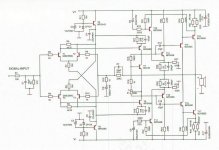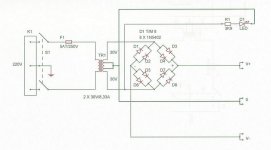Hello @All,
Does anybody know anything about german amplifiers called aaron.
I happend to have one with broken power-on switch - which is not a problem, inside everything looks fine except for one resistor seems too small regarding wattage in PSU. The PSU itself looks strange as it uses 2x22 secondary from transformer connected to half wave rectifiers on board.
Anybody has any experience with them - after the PSU caps - large ones there is regulator and relay. Just after those large caps there are 2 resistors from +/- to ground but one is rated ~5W and the other looks like 1/4W - what is funny it does not seem to me that no service job has been done inside and the pcb looks like out of factory....:/
I am asking as I do not want have anyting burnt while using the unit when the power-on is exchanged.
Mine is Aaron no.6.
Any help apreciated.
Unfortunatelly I have no digicam to take a photo🙁
Thanks!
Does anybody know anything about german amplifiers called aaron.
I happend to have one with broken power-on switch - which is not a problem, inside everything looks fine except for one resistor seems too small regarding wattage in PSU. The PSU itself looks strange as it uses 2x22 secondary from transformer connected to half wave rectifiers on board.
Anybody has any experience with them - after the PSU caps - large ones there is regulator and relay. Just after those large caps there are 2 resistors from +/- to ground but one is rated ~5W and the other looks like 1/4W - what is funny it does not seem to me that no service job has been done inside and the pcb looks like out of factory....:/
I am asking as I do not want have anyting burnt while using the unit when the power-on is exchanged.
Mine is Aaron no.6.
Any help apreciated.
Unfortunatelly I have no digicam to take a photo🙁
Thanks!
Thanks a lot Franklin!!!
It is not identical but I can see some resemblances to pcb and parts used. I do not think the topology was much different as on pcb I can se empty places for more output transistors and jumpers to feed them with PSU as if it is ready to scale up for more power.
The output devices in mine are not mj1500x thouhg...
Anyway the scheme answers my worries - the resistors shall be rated at 5W as on the +/- nodes on the picture you have attached.
Great help!
Greetings!
It is not identical but I can see some resemblances to pcb and parts used. I do not think the topology was much different as on pcb I can se empty places for more output transistors and jumpers to feed them with PSU as if it is ready to scale up for more power.
The output devices in mine are not mj1500x thouhg...
Anyway the scheme answers my worries - the resistors shall be rated at 5W as on the +/- nodes on the picture you have attached.
Great help!
Greetings!
Yeap,
Having closer look at scheme I can see most of devices and ratings are matching 100%, except for mine have more uF in PSU and output devices are different. The drivers, caps, etc are the same.
Having closer look at scheme I can see most of devices and ratings are matching 100%, except for mine have more uF in PSU and output devices are different. The drivers, caps, etc are the same.
Should you still have questions about your nipple amplifier:
I know Thomas Hohne from the early days when he set up the Aaron line and started selling them, Neumann and Sovereign amplifiers.
The Aaron amplifiers are manufactured in Holland nowadays.
They still have a German Aaron internet site with a tech support line.
I know Thomas Hohne from the early days when he set up the Aaron line and started selling them, Neumann and Sovereign amplifiers.
The Aaron amplifiers are manufactured in Holland nowadays.
They still have a German Aaron internet site with a tech support line.
Hi jacco,
Yes - I know the we-site.
I was about to write to them regarding my questions - now having the scheme I am sure the resistor vattage in psu is too small. The proper value I can check so I am going to exchange it for 5Watts. Rest of the parts look the sam for 2 channels and have not been touched by any service I think. The amplifier inside seems quite well manufactured and except for need to exchange few screws on the case I do not expect much trouble.
Dou you have any experience with these units?
What about sound? ....
I bought it second-hand for little money and in few days I will be back home and start it up and see myself🙂
Yes - I know the we-site.
I was about to write to them regarding my questions - now having the scheme I am sure the resistor vattage in psu is too small. The proper value I can check so I am going to exchange it for 5Watts. Rest of the parts look the sam for 2 channels and have not been touched by any service I think. The amplifier inside seems quite well manufactured and except for need to exchange few screws on the case I do not expect much trouble.
Dou you have any experience with these units?
What about sound? ....
I bought it second-hand for little money and in few days I will be back home and start it up and see myself🙂
Hello mad_z,
I'm glad the schematics could be of help to you and of course that you are able to solve the problem.
I cloned the Aaron 3 some 12 years ago. It is a class A/B amp but reveals more detail when quiescent current is raised to semi-class A. But if you attempt to do that, be caredfull! Turning the potmeter the wrong way may blow up the output transistors.
I will put a link on the website to download the schematics, wiring schematic and Eagle PCB-layout I made back then.
Hope you enjoy your Aaron 6.
I'm glad the schematics could be of help to you and of course that you are able to solve the problem.
I cloned the Aaron 3 some 12 years ago. It is a class A/B amp but reveals more detail when quiescent current is raised to semi-class A. But if you attempt to do that, be caredfull! Turning the potmeter the wrong way may blow up the output transistors.
I will put a link on the website to download the schematics, wiring schematic and Eagle PCB-layout I made back then.
Hope you enjoy your Aaron 6.
mad_z said:
Anybody has any experience with them - after the PSU caps - large ones there is regulator and relay. Just after those large caps there are 2 resistors from +/- to ground but one is rated ~5W and the other looks like 1/4W - what is funny it does not seem to me that no service job has been done inside and the pcb looks like out of factory....:/
Hi mad_z
What is the value in Ohms of the resistors?
The 5W resistors in the schematic , are not between rails and ground as in your post.
Right Tube Dude😉
The PSU of Aaron no.6 differs from what I can see on the scheme and it was my mistake. The amplifier topology seems the same(the same amount of transistors, caps values, transistor types(except for power transistors) etc.... The 5W resistors on scheme posted are for power transistors - mine amp has additional 5W in psu to ground - I will be back home in 2 days and I will post some photos of internals. I am still wondering if these PSU resistors I am talking about are overrated - they seem to drop some voltage for relay and it is hard to see reason for 5W anyway.
I guess it will be easier when I post some photos.
@Franklin: The web site with schemes and all what you can provide would be of great help - for me and others I think.
The PSU of Aaron no.6 differs from what I can see on the scheme and it was my mistake. The amplifier topology seems the same(the same amount of transistors, caps values, transistor types(except for power transistors) etc.... The 5W resistors on scheme posted are for power transistors - mine amp has additional 5W in psu to ground - I will be back home in 2 days and I will post some photos of internals. I am still wondering if these PSU resistors I am talking about are overrated - they seem to drop some voltage for relay and it is hard to see reason for 5W anyway.
I guess it will be easier when I post some photos.
@Franklin: The web site with schemes and all what you can provide would be of great help - for me and others I think.
Hello mad_z,
Tube dude is indeed right. Your question is related to another resistor found in the psu which I also overlooked.
You can download the Aaron 3/4 Eagle (4.16) files from this link:
https://s54.yousendit.com/d.aspx?id=302Y249UXJ78W13BNKRZZI2Q3D
(Link should be one line, so cut and paste if needed)
The wiring schematic can have minor errors, so if someone decides to build the amp, keep that in mind. PCB and SCH are OK.
Hope this helps.
Tube dude is indeed right. Your question is related to another resistor found in the psu which I also overlooked.
You can download the Aaron 3/4 Eagle (4.16) files from this link:
https://s54.yousendit.com/d.aspx?id=302Y249UXJ78W13BNKRZZI2Q3D
(Link should be one line, so cut and paste if needed)
The wiring schematic can have minor errors, so if someone decides to build the amp, keep that in mind. PCB and SCH are OK.
Hope this helps.
mad_z said:What about sound?
I've heard some of the MOSFET Neumann, BJT Aaron and even the goldplated pillar size Sovereign amplifiers in Thomas Hohne's audio store and at German audio shows.
As you can see from the Aaron 6 you've got and the schematic a lot of the money went into the chassis, and the 6 is an economic version.
Much of the electronics is solid, but not shocking.
I found both the Neumann and the Aaron models pretty cold on the feel and the sound, giving it more bias was the first that came to my mind then, i agree with the suggestion posted.
My second thought however, would be to use the nice chassis and stuff it with something more appealing.
I remember the design flaw of the Neumann A100.2, that brand was launched before Aaron by Hohne. A stereo 60 watt MOSFET amplifier with a fat resistor between the entrance socket and the fuse to limit the inrush to the toroid powersupply, and never giving the full load to the PS.
Hello @All,
Now having the amp running for some hours I can say only this:
Unemotional & cold sound.
Any ideas how to increase bias? What values shall I set - is there any ratio I can count how much I can turn the pot until it is too much for transistors?
I have multimeter at hand and shall be able to check bias as it is now.
Any help apreciated🙂
Thank you for support.
PS. In worst case I will stuff this nice chasis withs sth else....as "jaco" suggests.
Now having the amp running for some hours I can say only this:
Unemotional & cold sound.
Any ideas how to increase bias? What values shall I set - is there any ratio I can count how much I can turn the pot until it is too much for transistors?
I have multimeter at hand and shall be able to check bias as it is now.
Any help apreciated🙂
Thank you for support.
PS. In worst case I will stuff this nice chasis withs sth else....as "jaco" suggests.
Hi mad_z,
It is possible to increase the bias level, but do it with minimal steps. Determine the bias-current by measuring the voltage accross one of the emitter resistors of the output transistor. Devide the voltage you read on your meter by the resistor value and you have the bias-current. Now slowly and carefully turn the bias potmeter and monitor the reading of your meter very closely. An increase in voltage means an increase in bias-curent. You will have to determine how hot the output transistors get and it also depends on how much heat the heatsinks can dissipate.
After you have set an acceptable save bias level, you will notice the sound is more open and detailed, but still somewhat "cold". Depending on the speakers you use you may experience some listening fatigue after a while as I encountered with the Aaron 3.
Hope this helps. Let us know how it turned out.
It is possible to increase the bias level, but do it with minimal steps. Determine the bias-current by measuring the voltage accross one of the emitter resistors of the output transistor. Devide the voltage you read on your meter by the resistor value and you have the bias-current. Now slowly and carefully turn the bias potmeter and monitor the reading of your meter very closely. An increase in voltage means an increase in bias-curent. You will have to determine how hot the output transistors get and it also depends on how much heat the heatsinks can dissipate.
After you have set an acceptable save bias level, you will notice the sound is more open and detailed, but still somewhat "cold". Depending on the speakers you use you may experience some listening fatigue after a while as I encountered with the Aaron 3.
Hope this helps. Let us know how it turned out.
Mad_z,
Measure the voltage accross the 0.18 Ohm emitter resistor from one of the output transistors for proper bias current reading and adjusting!
Success!
Measure the voltage accross the 0.18 Ohm emitter resistor from one of the output transistors for proper bias current reading and adjusting!
Success!
Aaron modification
In the schematic posted earlier, look for the circuit around T10 and T11. When current over T15 and T17 rises, the voltage over resistors R33 and R34 rises, giving T10 and T11 a reason to conduct. When this happens, the signal that comes out of T12 and T13 is compressed. Removing T10 and T11 and the resistors around it cleans up the output signal dramatically.
Bypass C6 with a 1 uF MKT capacitor > very important!
Another modification you can do is change the polypropylene capacitors with ceramic types (when this has not been done already)
Add a 100nF MKT capacitor to C2 and C3. High frequencies are reproduced better.
Final tips: when making changes to any amplifier, test the output with an oscilloscope while powering it up with a variac. Also measure the voltage drop over R33 and R34 to be around 5 mV in case of the Aaron nr 6 😉
Greets,
Doedolf
In the schematic posted earlier, look for the circuit around T10 and T11. When current over T15 and T17 rises, the voltage over resistors R33 and R34 rises, giving T10 and T11 a reason to conduct. When this happens, the signal that comes out of T12 and T13 is compressed. Removing T10 and T11 and the resistors around it cleans up the output signal dramatically.
Bypass C6 with a 1 uF MKT capacitor > very important!
Another modification you can do is change the polypropylene capacitors with ceramic types (when this has not been done already)
Add a 100nF MKT capacitor to C2 and C3. High frequencies are reproduced better.
Final tips: when making changes to any amplifier, test the output with an oscilloscope while powering it up with a variac. Also measure the voltage drop over R33 and R34 to be around 5 mV in case of the Aaron nr 6 😉
Greets,
Doedolf
Hello Doedolf and Franklin,
Thank you for all hints and help with that one - this amplifer got attention from my friend so he was using it for some months to power old KEF speakers, as far as I remember he stated that brittle sound of Aaron and those speakers made nice combo. I did bias measurments - as far as I remember was set equally for both channels and soon said goodbye to amp itself. None mods applied.
I hope all your inputs will help other users to improve the unit!
Best Regards.
mad_z
Thank you for all hints and help with that one - this amplifer got attention from my friend so he was using it for some months to power old KEF speakers, as far as I remember he stated that brittle sound of Aaron and those speakers made nice combo. I did bias measurments - as far as I remember was set equally for both channels and soon said goodbye to amp itself. None mods applied.
I hope all your inputs will help other users to improve the unit!
Best Regards.
mad_z
- Status
- Not open for further replies.
- Home
- Amplifiers
- Solid State
- Aaron amplifiers


